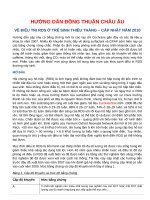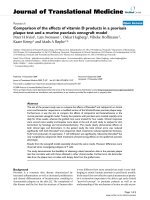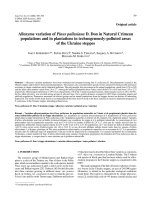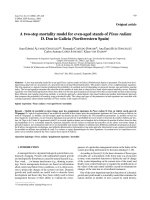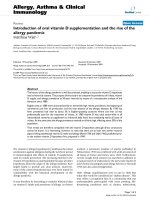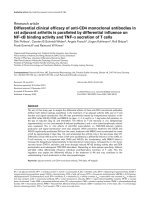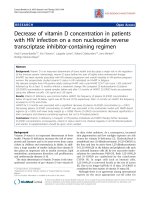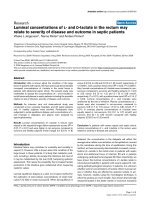Differential low uptake of free vitamin D supplements in preterm infants: The Quebec experience
Bạn đang xem bản rút gọn của tài liệu. Xem và tải ngay bản đầy đủ của tài liệu tại đây (417.43 KB, 7 trang )
Fatani et al. BMC Pediatrics 2014, 14:291
/>
RESEARCH ARTICLE
Open Access
Differential low uptake of free vitamin D
supplements in preterm infants: the Quebec
experience
Tarah Fatani1, Atul K Sharma2, Hope A Weiler3, Odile Sheehy4, Anick Bérard4,5 and Celia Rodd2*
Abstract
Background: Vitamin D is essential for bone mineralization, particularly in premature infants. For nearly 20 years,
Quebec has offered a program of free vitamin D supplements via its public medication insurance plan Régie de
l’Assurance Maladie du Québec (RAMQ). The objective of this study is to evaluate the number of preterm infants that
obtained at least one bottle (50 doses) of vitamin D supplement through this program and to determine if uptake
varied by gestational age.
Methods: This was a retrospective cohort study of preterm infants covered by RAMQ and born from 1998 to 2008;
all infants had 1 year of follow-up data regarding supplement use. Data were extracted from the Quebec Pregnancy
Cohort, a linked administrative database and were stratified by early (<34 weeks) or late gestational age premature
infants. The number of infants obtaining supplements was the primary outcome and their characteristics were
compared across gestational age groups. Predictors for participation (obtaining at least 1 bottle) or adherence
(2 or more bottles) were identified via logistic regression (GEE).
Results: 10288 infants were eligible; the percentage exposed to vitamin D was 24.5% (37.4%- early; 20.7%-late
preterm infants, p < 0.001). The median number of bottles obtained was 2 for early and 1 for late preterms. For all
premature infants, there was an apparent geometric decline in the infants obtaining subsequent bottles of
supplements over the 12 month period. Additionally, there was a significant decline in program participation over
time (OR = 0.90/year, 95% CI: 0.89-0.90) regardless of gestational age. Older or more educated mothers were
positive predictors for participation. A prescription from a pediatrician significantly increased the odds of obtaining
the supplement.
Conclusion: Early preterm infants were more likely to obtain the supplement post-discharge; uptake was low and
decreased with time for both age categories. Specifically, targeting late preterm infants and young mothers with
less education could improve vitamin D uptake.
Keywords: Premature infants, Vitamin D, Supplementation, Mineralization, Fractures, Early preterm, Socioeconomic
status, Education
Background
Preterm infants are at risk for bone health issues; the
third trimester is a period of enhanced mineral transfer
from mother and rapid bone mass accrual [1,2]. Since
postnatal nutritional support cannot replicate the rich in
utero environment, preterm infants may have fragility
* Correspondence:
2
Department of Pediatrics, Winnipeg Children’s Hospital, 685 William Avenue,
FW302, Winnipeg R3E 0Z2, Manitoba, Canada
Full list of author information is available at the end of the article
fractures before and after discharge; fracture rates range
from 2-10% [1,2]. Measures to reduce such complications include special formulas or breast milk fortified
with minerals, vitamins and protein [1,2]. Consensus
has not yet been achieved on the dosage of vitamin D
that preterm infants should receive but all preterm
infants should receive a supplement as per established
guidelines. European recommendations of 800–1000 IU/
day are about double North American recommendations of 400 IU/d [3,4]. Many infants, particularly young
© 2014 Fatani et al.; licensee BioMed Central Ltd. This is an Open Access article distributed under the terms of the Creative
Commons Attribution License ( which permits unrestricted use, distribution, and
reproduction in any medium, provided the original work is properly credited. The Creative Commons Public Domain
Dedication waiver ( applies to the data made available in this article,
unless otherwise stated.
Fatani et al. BMC Pediatrics 2014, 14:291
/>
preterm infants, are not capable of consuming sufficient
formula to meet these recommendations, and breast fed
infants also require supplementation because of the low
concentration of vitamin D in breast milk [5]. Hence,
there is a need for vitamin D supplementation for all
preterm infants regardless of feeding modality.
Different jurisdictions promote vitamin D supplementation with various strategies; nevertheless, success has
been variable and barriers still exist. In the UK, a system
of coupons exchangeable for bottles of vitamin D has
been instituted by the National Health Service (NHS)
and has partially succeeded [6]. Turkey provides vitamin
D via prescription [7]. We have recently reported that
the province of Quebec has for 20 years utilized a program of free supplements via prescription without a
major educational component [8]. Participation (obtaining
1 or more bottles) was limited to only 18% of full term infants during the period 1998–2009. Vitamin D exposure to
infants declined over time in the face of a doubling of exclusive breastfeeding for the first 6 mo. of age from 20032009 [9]. This appeared to translate into a modest increase
in the number of cases of rickets over this time [8].
The objective of this study is to evaluate the number of
preterm infants that obtained at least one bottle (50 doses)
of vitamin D supplement through this program and to determine if uptake varied by gestational age., using a linked
administrative database (Quebec Pregnancy Cohort or
QPC) [10]. We anticipated that the participation would
be low, similar to term infants. Secondary objectives including assessing whether uptake by early preterm infants (born <34 weeks) might be different than infants
born closer to term (late preterm 34- 366/7 weeks)
[11]. Long term adherence (obtaining 2 or more bottles) was also examined, as were likely predictors, such
as maternal education and physician specialty providing the prescription, which we have previously identified as important and modifiable factors in term infants
in Quebec [8].
Methods
Study population
This was a retrospective analysis of an annual birth cohort
of all preterm infants in Quebec born between January 1,
1998 and December 31, 2008. All data are obtained from
the QPC, a validated, comprehensive and continuing
population-based cohort [10,12,13]. This includes all
pregnancies of women covered by the Régie de l’Assurance
Maladie du Québec (RAMQ) medication insurance plan;
about 30% of all pregnant women are covered by RAMQ
while the rest have private group insurance. The QPC is
created from a linkage of 3 administrative data bases including RAMQ (medical services and prescription claims),
MED-ECHO (hospitalizations) and Institut de la Statistique du Québec (birth registry) using the maternal and
Page 2 of 7
child provincial health record numbers, date of births and
names [10]. As described in more detail in the manuscript
concerning term uptake, information such as prescription
medications, socioeconomic status (SES), health care provider’s details, hospitalizations, and parental demographics
are available in the QPC [8].
In 1994, the first vitamin D preparation was placed on
the RAMQ formulary; this was free for social assistance
recipients. Since 1997, supplements have been free via
prescription for all participants of the RAMQ plan, with
comparable coverage provided by all private group insurance programs.
Patient eligibility included all preterm infants (born
<37 weeks) during the study period; these infants were
further subdivided into early (<34 weeks) and late preterm infants (34 to 366/7 weeks) [11]. Their mothers
needed to be covered by the RAMQ plan for the first
12 months post-delivery, and information about the
duration of hospitalization was required. Infants with
rare rachitic disorders such as renal failure, X-linked
hypophosphatemic rickets, and infants and mothers
treated with calcitriol were excluded using ICD-9 and
ICD-10 codes.
Data analysis
Our primary outcome was the number of preterm infants participating in this free vitamin D program in
each calendar year between 1998 and 2009 (born 1998
till 2008 with at least 12 months of follow up). Participation was defined as a preterm infant obtaining at least
one bottle of vitamin D during the first year of life. Secondary outcomes included adherence to the program
(obtaining two or more prescription over the same time
period) and whether participation or adherence varied
by gestational age.
The insured vitamin preparations (400 IU/d of vitamin
D) are all 50 dose bottles (1 ml = 1dose); the preparations included D-Vi-Sol®, Jamp-Vitamin D® and PediaVit
D® and the multivitamin preparations Jamp-Vitamins AD-C®, PediaVit® and Tri-Vi-Sol®. Baby Ddrops® (1drop =
400 IU) were added to the formulary in late 2009 but
was not available during the study time frame.
Covariates for all outcomes include maternal age, postsecondary education, living status (couple vs. single),
urban vs. rural, registrant vs. welfare recipient (RAMQ
status), calendar year, specialty of prescribing physician,
gestational age, birth weight, and sex of infant. Information on feeding method, parity and ethnicity were not
available for use as potential confounders. The season of
procurement of the first bottle of supplement was included to account for possible reliance on cutaneous production of vitamin D; October1 to March 31 was deemed
the non-synthesizing period for vitamin D based on the
low zenith angle of the sun for Quebec [14].
Fatani et al. BMC Pediatrics 2014, 14:291
/>
Page 3 of 7
Statistical methods
Descriptive statistics were used to compare the all preterms exposed to vitamin D supplements vs. those who
were not. All analyses were repeated to determine if
these varied by gestational age. Results are expressed as
means and standard deviations or medians with range or
percentages as appropriate. Multivariate logistic regression models were utilized to assess temporal trends in
program participation and adherence and to identify
additional predictors for both participation and adherence. Generalized estimating equations (GEE) were utilized to account for familial clustering (by mothers).
Appropriate regression diagnostics were performed; statistical analyses were done using SAS (SAS institute Inc.,
Version 9.2, Cary, NC, USA).
Ethics
The Research Ethics Committees at the Montreal Children’s Hospital, McGill University Health Center and
CHU-Ste-Justine granted approval. The access to the
data used to create the Quebec Pregnancy Cohort was
authorized by the Commission d’Accès à l’Information
and approved by the CHU-Ste-Justine ethics committee.
Results
During the time frame of interest, 149307 infants were
born in Quebec; 11504 (7.7%) were born at less than
37 weeks gestational age. After applying eligibility
criteria, 10288 infants were available for analysis; the
majority of these were born late preterm (n = 7819).
Tables 1 and 2 present maternal, infant (Table 1) and
physician characteristics (Table 2) regarding uptake of
the free supplement program.
Roughly a quarter (24.5%) of all preterms participated; a higher proportion of early preterms obtained
at least one bottle of vitamin D compared to those
born after 34 weeks (37.4% vs. 20.7%, p < 0.0001) Additionally, a higher percentage of early preterm infants
were likely to obtain more than 1 bottle of supplements via this program (61.6%) compared to late preterms (49.7%, p <0.0001). The median number of
bottles procured was higher with 2 (range; 1–12) vs. 1
(range; 1–15) in those infants born earlier. The median
time to procure the first supplement was longer in
those born earlier (62 vs. 35 days). The only consistent
predictors in both groups (assessed separately or together) for participation (obtaining 1 or more bottles
over 12 mo) were specialty of infant’s physician and a
lesser weight at delivery (Table 3).
The single consistent predictor for ‘total’, early or late
premature infants was calendar year of delivery after adjustment; this was negatively associated (OR = 0.90 per
year, 95% CI: 0.89-0.90). For late and ‘total’ preterms,
higher maternal age, more education, prescription provided by a pediatrician or shorter duration of pregnancy
were positive predictors for participation after adjustment for the other variables in the model. Adherence
(obtaining 2 or more prescriptions over 12 months
compared to those obtaining 1 prescription or no vitamin D) was also explored using a multivariate logistic
regression (Table 4).
For both gestational age categories and ‘total’ preterms, an older mother was positively associated, and
the year of delivery was negatively associated. When
evaluating adherence, the only positive predictors were
a mother with more education, a shorter duration of
Table 1 Characteristics of women and infants with respect to vitamin D exposure in infancy
Characteristics
Early preterm n = 2409
Late preterm n = 7819
Total n = 10288
Exposed
infants
n = 902
Unexposed
infants
n = 1507
p value Exposed
infants
n = 1618
Unexposed
infants
n = 6201
p value Exposed
infants
n = 2520
Unexposed
infants
n = 7708
p value
27.7 ± 6.0
28.0 ± 6.1
0.284
27.7 ± 5.7
0.010
27.8 ± 5.8
0.136
Mothers’ characteristics
Age, years, mean ± SD
28.1 ± 5.9
28.0 ± 6.0
Welfare recipient, % (n)
26.5 (239)
25.7 (387)
0.669
27.7 (448)
24.0 (1490)
0.002
27.3 (687)
24.4 (1877)
0.003
Mothers living
alone, % (n)
22.1 (199)
21.3 (321)
0.665
19.1 (309)
20.2 (1251)
0.337
20.2 (508)
20.4 (1572)
0.802
Post-secondary education 36.1 (326)
level, % (n)
35.8 (539)
0.851
40.8 (660)
35.4 (2193)
< 0.001 39.1 (986)
35.4 (2732)
< 0.001
Urban living, % (n)
76.9 (694)
80.5 (1213)
0.046
78.2 (1266)
78.5 (4866)
0.845
78.9 (6079)
0.259
Gestational age, weeks,
mean ± SD
30.4 ± 2.5
30.6 ± 2.7
0.25
35.3 ± 0.8
35.4 ± 0.7
< 0.001 33.6 ± 2.8
34.5 ± 2.4
< 0.001
Weight at delivery,
grams, mean ± SD
1577.9 ± 711.8 1657.7 ± 612.5 < 0.001 2573.4 ± 552.8 2649.1 ± 477.6 < 0.001 2217.0 ± 777.9 2455.2 ± 641.4 < 0.001
Male gender, % (n)
52.6 (474)
77.8 (1960)
Infants’ characteristics
54.9 (828)
0.252
50.9 (823)
53.8 (3335)
0.044
51.5 (1297)
54.0 (4163)
0.037
Fatani et al. BMC Pediatrics 2014, 14:291
/>
Page 4 of 7
Table 2 Characteristics of physicians prescribing and adherence and participation
Early preterm n = 2409
Characteristics
Late preterm n = 7819
Total n = 10288
Exposed
infants
n = 902
Unexposed p value Exposed
infants
infants
n = 1618
n = 1507
Unexposed p value Exposed
infants
infants
n = 2520
n = 6201
Unexposed p value
infants
n = 7708
23.9 (216)
17.7 (267)
43.4 (2692)
38.4 (2959)
Specialty of the infants’ physician, % (n)
General Practitioner
< 0.001 39.2 (635)
< 0.001 33.8 (851)
< 0.001
Paediatrician
73.5 (663)
53.8 (811)
57.5 (930)
47.7 (2958)
63.2 (1593) 48.9 (3769)
Obstetrician- Gynaecologist
0.3 (3)
0.0 (0)
1.2 (20)
0.0 (0)
0.91 (23)
0.0 (0)
Other specialist
2.2 (20)
28.5 (429)
2.0 (33)
8.9 (551)
2.1 (53)
12.7 (980)
% of infants obtaining 2 or more
bottles of Vitamin D (n)
61.6 (556)
-
-
49.7 (805)
-
-
54.0 (1361) -
Age at the time of the first prescription.
days. median (min-max)
62 (8–397) -
-
35 (1–400) -
-
49 (2–400) -
Number of vitamin D prescriptions
2 (1–12)
-
-
1 (1–15)
-
-
2 (1–15)
-
-
51.3 (463)
-
-
52.4 (848)
-
-
52.0 (1311) -
-
-
Among infants with 1 or more vitamin D
prescription
median (min-max)
Infants initiating vitamin D during
non-synthesizing period ……….% (n)*
*
Non synthesizing period: October 1st to March 31st.
pregnancy, and having a pediatrician care for the late
and ‘total’ preterms.
The Figure 1 presents the number of infants obtaining 1
or more bottles; a steep drop was noted in the number of
infants obtaining 2 or more bottles over a 12 mo. period.
Discussion
Overall, preterm infants had low participation in the free
vitamin D program, with only ~25% of them obtaining
at least one bottle of supplement. Interestingly, nearly
twice the number of early preterm (born <34 weeks)
procured bottles via this program compared to late preterms (37.4% vs. 20.7%). As previously noted, only 18.2%
of term infants from Quebec participated in this program over the same time frame [8]. Both late preterm
and term infants also obtained a median number of 1
bottle (50 doses) of vitamin D during their 12 month follow up, while those born at <34 weeks procured enough
(median) for 100 doses.
To date, there do not appear to be other manuscripts
evaluating the programs promoting vitamin D supplements specifically in premature infants. Programs for all
Table 3 Predictors of participation in the vitamin D program (infants with one or more prescription)
Characteristics
Maternal age (year)
Early preterm
Late preterm
Total
OR
CI
OR
CI
OR
CI
1.00
0.98-1.01
1.01
1.00-1.02
1.01
1.00 - 1.02
Welfare recipient vs. adherent
0.84
0.67-1.05
1.12
0.97-1.29
1.05
0.93 – 1.19
Living alone vs. couple
1.10
0.89-1.37
0.93
0.80-1.09
0.99
0.87 – 1.12
Level of education: ≤12 years vs. >12 years
1.02
0.84-1.23
0.77
0.68-0.87
0.83
0.75 – 0.93
Rural vs. urban resident
1.22
0.97-1.53
1.04
0.90-1.19
1.08
0.96 – 1.22
Duration of pregnancy (week)
1.00
0.93-1.09
0.88
0.81-0.96
0.91
0.88 – 0.95
Birth weight (grams)
1.00
1.00-1.00
1.00
1.00-1.00
1.00
1.00 – 1.00
Male gender infants
1.02
0.86-1.21
0.95
0.85-1.06
0.97
0.88 – 1.07
Year of delivery
0.93
0.91-0.96
0.89
0.87-0.90
0.90
0.89 – 0.92
Non synthesizing* vs. synthesizing period
1.01
0.84-1.22
1.07
0.95-1.20
1.06
0.96 – 1.17
Paediatrician
0.92
0.74-1.16
1.23
1.09-1.39
1.21
1.09 - 1.35
Other specialist
0.08
0.05-0.12
0.41
0.31-0.55
0.20
0.16 - 0.27
Infants followed up by General practitioner (reference)
st
st
*Non synthesizing period: October 1 to March 31 .
Fatani et al. BMC Pediatrics 2014, 14:291
/>
Page 5 of 7
Table 4 Predictors of adherence in the vitamin D program (infants obtaining 2 or more prescriptions)
Characteristics
Maternal age (year)
Early preterm
Late preterm
Total
OR
CI
OR
CI
OR
CI
1.03
1.01-1.05
1.03
1.02-1.05
1.03
1.02 – 1.04
Welfare recipient vs. adherent
0.81
0.62-1.05
1.06
0.88-1.28
0.98
0.84 – 1.15
Living alone vs. in couple
1.01
0.76-1.33
0.91
0.74-1.12
0.96
0.82 – 1.13
Level of education: ≤12 years vs. >12 years
0.92
0.75-1.14
0.76
0.64-0.89
0.81
0.71 – 0.93
Rural vs. urban resident
1.03
0.79-1.36
1.08
0.90-1.31
1.07
0.92 – 1.24
Duration of pregnancy (week)
0.98
0.90-1.06
0.84
0.76-0.94
0.91
0.88 - 0.95
Birth weight (grams)
1.00
1.00-1.00
1.00
1.00-1.00
1.00
1.00 – 1.00
Male gender infants
1.11
0.90-1.36
1.04
0.90-1.21
1.04
0.92 – 1.17
Year of delivery
0.94
0.90-0.97
0.90
0.88-0.92
0.91
0.89 - 0.93
Non synthesizing* vs. synthesizing period
1.07
0.87-1.32
1.02
0.87-1.19
1.03
0.91 – 1.16
Paediatrician
1.08
0.84-1.39
1.29
1.09-1.52
1.27
1.11 - 1.45
Other specialist
0.11
0.06-0.19
0.47
0.32-0.69
0.23
0.16 - 0.32
Infants followed up by General practitioner (reference)
st
st
*Non synthesizing period: October 1 to March 31 .
infants in the UK and in Turkey have met with variable
success [7,15]; Turkey in particular has recently dramatically reduced its rate of rickets (6.8% to 0.1%) and improved the vitamin D status of its young children.
Despite comprehensive campaigning, Birmingham has
had a more moderate degree of success, with a tripling
of uptake (5% to 17%) [15]. Those born 35 weeks or
older in Quebec had a similar rate to Birmingham’s, but
without their educational component [15]. One might
speculate that promotional efforts like Birmingham’s
might increase uptake several fold. Steps such as informing all physicians that vitamin D is free of charge to families and measures at nurseries, local pharmacies and
physician’s offices are logical targets to advertise the program and reinforce the need for vitamin D.
This low utilization is at odds with the reports from
the Canadian Community Health Survey and 2 other
Canadian surveys, which typically addressed uptake of
vitamin D in healthy term infants [16-18]. The difference
may reflect biases in obtaining the data, such as recall
bias (increasing vitamin D utilization when parents were
surveyed) or that the 2 smaller surveys focused on urban
populations. Our findings may also have excluded families purchasing vitamin D over-the-counter due to the
failure of caregivers to provide prescriptions, beliefs that
breast milk is complete, or challenges administering the
available products.
Unfortunately, in all 3 groups (term, and 2 preterm
groups), there was a significant decline in participation
in the free program between 1998 and 2009 despite a
Figure 1 Number of bottles of vitamin D supplements obtained over infancy in all preterm infants.
Fatani et al. BMC Pediatrics 2014, 14:291
/>
province wide increase in exclusive breast feeding out to
6 mo (9 to 19% from 2003 to 2009) [8,9,16]. Older
mothers, those with more education, and a prescription
from a pediatrician increased the odds of both participation and adherence; there was a striking degree of
consistency amongst predictors across all gestational
ages, including term [7,8,19]. Because of the small numbers of early preterms, some of these predictors were
only significant in the late preterm or total group.
The participation rate and higher numbers of bottles
obtained in early preterms compared to late preterm or
older infants might suggest possible explanations: Some
NICUs or hospital nurseries may be promoting breastfeeding or vitamin D differently in these groups; parents
and health-care givers may also perceive bone health risk
differently in these vulnerable infants [20-23].
Specifically some hospitals have developed Family Care
units with emphasis on breastfeeding promotion [23].
We hypothesize that these units may have placed particular emphasis on supplementation given that breast
milk typically has low concentrations of vitamin D [23].
Additionally, evidence that breast milk may prevent disorders such as necrotizing enterocolitis or respiratory illnesses may also increase breastfeeding, particularly in
those infants born at a younger gestational age [22].
Some literature suggests that late preterm infants are at
times sent home relatively quickly with perhaps less support for breastfeeding, which may result in an earlier
move to fortified formula [20,21]; this may then reduce
the promotion of vitamin D for near-term infants. Unfortunately, we are not aware of the specific feeding modality in our populations.
Differential uptake may also reflect actual fractures
or problems with mineral homeostasis during the hospitalization, prompting parents of early preterm infants
to more eagerly adopt vitamin D supplements and continue them for a longer duration [1]. In general, parents
of preterm infants perceive them to be more vulnerable
than term infants, which may lead to more vigorous
utilization of vitamin supplements [24]. Detailed data at
an individual level were not available to us to support
these hypotheses.
Our data were too limited to evaluate the impact of
declining vitamin D uptake over time in just our preterm cohort; we previously reported the modest increase
in rickets between 1998 and 2009 in infants of all gestational age in the QPC [8]. Additionally, we cannot comment in detail on the timing of procuring the first bottle
of supplements. In term infants, there was a significant
delay (median time was 36 d), which is similar to the
median delay of 35 d in late preterm infants [8]. We do
not know the age of discharge from hospital for the preterm infants, and the delay out to 66 d in the early preterms likely represents longer hospital stays.
Page 6 of 7
Given the relatively better uptake in early preterm infants; we need to understand what prompted these families to obtain the supplements, unlike parents of later
gestational infants. These observations and the previously described risk factors (younger mothers and those
of lower SES) may allow Quebec and other jurisdiction
to focus efforts to increase supplementation rates [7,8].
Moreover, because premature infants are at risk for fragility fractures out to 1-2y of life and there is still uncertainty about their optimal intake; 400 IU/d seems to be a
reasonable target [25]. The utilization of special premature infant formula enriched in vitamin D and minerals
post-discharge might replace the need for supplementation, but this, remains controversial [2].
There are some limitations with our data, such as not
knowing the breastfeeding status of the infants, if the
families received a prescription, if they actually administered the supplements once procured, or if they obtained
vitamin D outside of the free program. The latter would
still be perceived to be a failure of the program.
Conclusion
All preterm infants had low uptake of the free supplement program, but early preterms demonstrated higher
participation rates and better adherence. This would
suggest that hospital-based interventions can improve
vitamin D supplement uptake. Clearly, additional targeted reinforcement is warranted because preterm infants remain at risk for fragility fractures, and infants of
young mothers with low education levels had lower
levels of participation in the program [26]. Moreover,
free vitamin D by prescription is clearly not sufficient
without additional reinforcement; endorsement from a
pediatrician appears to be particularly beneficial. These
data help identify vulnerable infants and families that require additional support to promote adequate vitamin D
intake.
Abbreviations
D: Day; IU: International units; ICD: International classification diseases; L: Litre;
Mo: Month; NHS: National Health Service; NICU: Neonatal intensive care unit;
QPC: Quebec Pregnancy Cohort; RAMQ: Régie de l’Assurance Maladie du
Québec; SES: Socioeconomic status; Y: Year.
Competing interests
The authors declare that they have no competing interests.
Authors’ contributions
CR, AS, HW, OS, TF and AB conceived the study and its design. OS, AB and
AS undertook the statistical analyses and all participated in drafting the
manuscript. All authors read and approved the final version.
Acknowledgements
This project was funded by the Montreal Children’s Hospital–Research
Institute and the Gray Family Fund. Neither agency was involved in the
design and conduct of the study; collection, management, analysis, and
interpretation of the data; preparation, review, or approval of the manuscript;
and decision to submit the manuscript for publication. Dr. Hope A. Weiler is
Fatani et al. BMC Pediatrics 2014, 14:291
/>
in receipt of a Canada Research Chair tier II in Nutrition, Development, and
Aging.
Author details
1
Department of Pediatrics, Montreal Children’s Hospital, Montreal, Quebec,
Canada. 2Department of Pediatrics, Winnipeg Children’s Hospital, 685 William
Avenue, FW302, Winnipeg R3E 0Z2, Manitoba, Canada. 3School of Dietetics
and Human Nutrition, McGill University, Ste-Anne-de-Bellevue, Quebec,
Canada. 4Research Center, Centre hospitalier universitaire Ste-Justine,
Montreal, Quebec, Canada. 5Faculty of Pharmacy, University of Montreal,
Montreal, Quebec, Canada.
Received: 11 August 2014 Accepted: 10 November 2014
References
1. Bishop N, Sprigg A, Dalton A: Unexplained fractures in infancy: looking for
fragile bones. Arch Dis Child 2007, 92(3):251–256.
2. Bozzetti V, Tagliabue P: Metabolic bone disease in preterm newborn: an
update on nutritional issues. Ital J Pediatr 2009, 35(1):20.
3. Braegger C, Campoy C, Colomb V, Decsi T, Domellof M, Fewtrell M, Hojsak I,
Mihatsch W, Molgaard C, Shamir R, Turck D, van Goudoever J, ESPGHAN
Committee on Nutrition: Vitamin D in the healthy European paediatric
population. J Pediatr Gastroenterol Nutr 2013, 56(6):692–701.
4. Wagner CL, Greer FR: Prevention of rickets and vitamin D deficiency in
infants, children, and adolescents. Pediatrics 2008, 122(5):1142–1152.
5. Reeve LE, Chesney RW, DeLuca HF: Vitamin D of human milk:
identification of biologically active forms. Am J Clin Nutr 1982,
36(1):122–126.
6. Jessiman T, Cameron A, Wiggins M, Lucas PJ: A qualitative study of uptake
of free vitamins in England. Arch Dis Child 2013, 98(8):587–591.
7. Hatun S, Ozkan B, Bereket A: Vitamin D deficiency and prevention: Turkish
experience. Acta paediatrica (Oslo, Norway: 1992) 2011, 100(9):1195–1199.
8. Millette M, Sharma A, Weiler H, Sheehy O, Berard A, Rodd C: Failure of free
vitamin D supplementation program for Quebec infants. Acta paediatrica
(Oslo, Norway: 1992) 2014, 103(10):e444–449.
9. Trends in breastfeeding practices in Canada (2001 to 2009–2010).
[ />10. Berard A, Lacasse A: Validity of perinatal pharmacoepidemiologic studies
using data from the RAMQ administrative database. Can J Clin Pharmacol
2009, 16(2):e360–e369.
11. Engle WA, Tomashek KM, Wallman C: “Late-preterm” infants: a population
at risk. Pediatrics 2007, 120(6):1390–1401.
12. Nakhai-Pour HR, Broy P, Berard A: Use of antidepressants during
pregnancy and the risk of spontaneous abortion. CMAJ 2010,
182(10):1031–1037.
13. Nakhai-Pour HR, Broy P, Sheehy O, Berard A: Use of nonaspirin
nonsteroidal anti-inflammatory drugs during pregnancy and the risk of
spontaneous abortion. CMAJ 2011, 183(15):1713–1720.
14. Webb AR, Kline L, Holick MF: Influence of season and latitude on the
cutaneous synthesis of vitamin D3: exposure to winter sunlight in
Boston and Edmonton will not promote vitamin D3 synthesis in human
skin. J Clin Endocrinol Metab 1988, 67(2):373–378.
15. Moy RJ, McGee E, Debelle GD, Mather I, Shaw NJ: Successful public health
action to reduce the incidence of symptomatic vitamin D deficiency.
Arch Dis Child 2012, 97(11):952–954.
16. Breastfeeding iniatation in Canada: key statistics and graphics
(2009–2010). [ />prenatal/initiation-eng.php]
17. Crocker B, Green TJ, Barr SI, Beckingham B, Bhagat R, Dabrowska B,
Douthwaite R, Evanson C, Friesen R, Hydamaka K, Li W, Simmons K, Tse L:
Very high vitamin D supplementation rates among infants aged
2 months in Vancouver and Richmond, British Columbia, Canada.
BMC Public Health 2011, 11:905.
18. Gallo S, Jean-Philippe S, Rodd C, Weiler HA: Vitamin D supplementation of
Canadian infants: practices of Montreal mothers. Appl Physiol Nutr Metab
2010, 35(3):303–309.
19. Shaikh U, Alpert PT: Practices of vitamin D recommendation in Las Vegas,
Nevada. J Hum Lact 2004, 20(1):56–61.
Page 7 of 7
20. Adamkin DH: Feeding problems in the late preterm infant. Clin Perinatol
2006, 33(4):831–837. abstract ix.
21. Ahmed AH: Role of the pediatric nurse practitioner in promoting
breastfeeding for late preterm infants in primary care settings. J Pediatr
Health Care 2010, 24(2):116–122.
22. Downard CD, Renaud E, St Peter SD, Abdullah F, Islam S, Saito JM, Blakely
ML, Huang EY, Arca MJ, Cassidy L, Aspelund G, 2012 American Pediatric
Surgical Association Outcomes Clinical Trials Committee: Treatment of
necrotizing enterocolitis: an American Pediatric Surgical Association
Outcomes and Clinical Trials Committee systematic review. J Pediatr Surg
2012, 47(11):2111–2122.
23. Wataker H, Meberg A, Nestaas E: Neonatal family care for 24 hours per
day: effects on maternal confidence and breast-feeding. J Perinat
Neonatal Nurs 2012, 26(4):336–342.
24. Bartlett DJ, Nijhuis-van der Sanden MW, Fallang B, Fanning JK, Doralp S:
Perceptions of vulnerability and variations in childrearing practices of
parents of infants born preterm. Pediatr Phys Ther 2011, 23(3):280–288.
25. Backstrom MC, Maki R, Kuusela AL, Sievanen H, Koivisto AM, Ikonen RS,
Kouri T, Maki M: Randomised controlled trial of vitamin D
supplementation on bone density and biochemical indices in preterm
infants. Arch Dis Child Fetal Neonatal Ed 1999, 80(3):F161–F166.
26. McCarthy RA, McKenna MJ, Oyefeso O, Uduma O, Murray BF, Brady JJ,
Kilbane MT, Murphy JF, Twomey A, O’ Donnell CP, Murphy NP, Molloy EJ:
Vitamin D nutritional status in preterm infants and response to
supplementation. Br J Nutr 2013, 110(1):156–163.
doi:10.1186/s12887-014-0291-6
Cite this article as: Fatani et al.: Differential low uptake of free vitamin D
supplements in preterm infants: the Quebec experience. BMC Pediatrics
2014 14:291.
Submit your next manuscript to BioMed Central
and take full advantage of:
• Convenient online submission
• Thorough peer review
• No space constraints or color figure charges
• Immediate publication on acceptance
• Inclusion in PubMed, CAS, Scopus and Google Scholar
• Research which is freely available for redistribution
Submit your manuscript at
www.biomedcentral.com/submit
